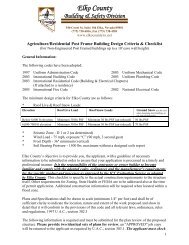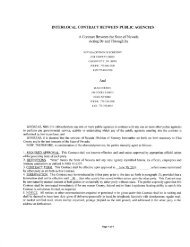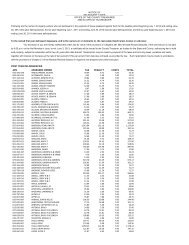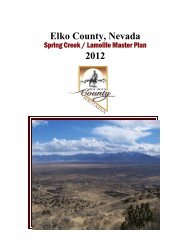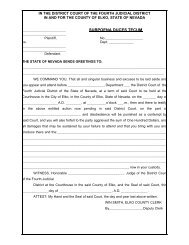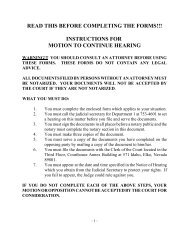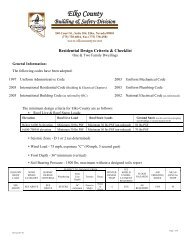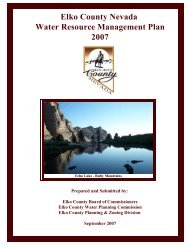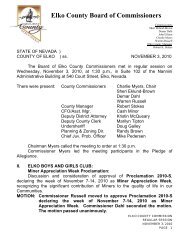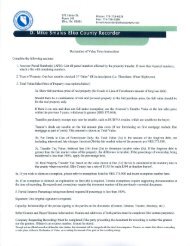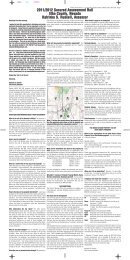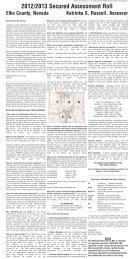Annual Consumer Confidence Report Montello, NV ... - Elko County
Annual Consumer Confidence Report Montello, NV ... - Elko County
Annual Consumer Confidence Report Montello, NV ... - Elko County
- No tags were found...
Create successful ePaper yourself
Turn your PDF publications into a flip-book with our unique Google optimized e-Paper software.
<strong>Annual</strong> <strong>Consumer</strong> <strong>Confidence</strong> <strong>Report</strong><strong>Montello</strong>, <strong>NV</strong>PWS <strong>NV</strong>0000169Spanish (Espanol)Este informe contiene informacion muy importante sobre la calidad de su agua beber. Traduscalo ohable con alguien que lo entienda bien.IntroductionIf you have any questions about this report or concerning your water utility, please contact <strong>Elko</strong> <strong>County</strong>Community Public Works Technician, Mr. Dale Johnson, at 540 Court Street Suite 104, <strong>Elko</strong>,Nevada (775) 738-6816. We want our valued customers to be informed about their water utility. <strong>Elko</strong><strong>County</strong> Commissioner meetings are held the first and third Wednesday of every month at 1:30pm located at <strong>Elko</strong> <strong>County</strong>, 540 Court Street Suite 105. Public comment is more than welcome atthese meetings. Please contact the Administration office for information regarding the agenda.The phone number is (775) 738-5938.Is my water safe?The <strong>Montello</strong> water system routinely monitors for constituents in your drinking water according toFederal and State laws. The following table shows the results of any detects in our monitoring for theperiod of January 1 st to December 31 st , 2009. For constituents that are not monitored yearly, we havereviewed our records back to the last time the constituent was monitored.We have monitored for lead and copper. Copper is an essential nutrient, but some people who drinkwater containing copper in excess of the action level over a relatively short amount of time couldexperience gastrointestinal distress. Some people who drink water containing copper in excess of theaction level over many years could suffer liver or kidney damage. People with Wilson’s disease shouldconsult their personal physician. If present, elevated levels of lead can cause serious health problems,especially for pregnant women and young children. Lead in drinking water is primarily from materialsand components associated with service lines and home plumbing. <strong>Montello</strong> is responsible forproviding high quality drinking water, but cannot control the variety of materials used in plumbingcomponents. When your water has been sitting for several hours, you can mimimize the potential forlead exposure by flushing your tap for 30 seconds to 2 minutes before using water for drinking orcooking. If you are concerned about lead in your water, you may wish to have your water tested.Information on lead in drinking water, testing methods, and steps you can take to minimize exposure isavailable from the Safe Drinking Water Hotline or at http://www.epa.gov/safewater/lead.Do I need to take special precautions?Some people may be more vulnerable to contaminants in drinking water than the general population.Immuno-compromised persons such as persons with cancer undergoing chemotherapy, persons whohave undergone organ transplants, people with HIV/AIDS or other immune system disorders, someelderly, and infants can be particularly at risk from infections. These people should seek advice aboutdrinking water from their health care providers. EPA/Centers for Disease Control (CDC) guidelines onappropriate means to lessen the risk of infection by Cryptosporidium and other microbial contaminantsare available from the Safe Water Drinking Hotline (800-426-4791).1
Where does my water come from?Our water source is drawn from spring sources outside the community and is disinfected at the waterstorage tank.Why are there contaminants in my drinking water?Drinking water, including bottled water, may reasonably be expected to contain at least small amountsof some contaminants. The presence of contaminants does not necessarily indicate that water poses ahealth risk. More information about contaminants and potential health effects can be obtained by callingthe Environmental Protection Agency's (EPA) Safe Drinking Water Hotline (800-426-4791). The sourcesof drinking water (both tap water and bottled water) include rivers, lakes, streams, ponds, reservoirs,springs, and wells. As water travels over the surface of the land or through the ground, it dissolvesnaturally occurring minerals and, in some cases, radioactive material, and can pick up substancesresulting from the presence of animals or from human activity:microbial contaminants, such as viruses and bacteria, that may come from sewage treatment plants,septic systems, agricultural livestock operations, and wildlife; inorganic contaminants, such as salts andmetals, which can be naturally occurring or result from urban stormwater runoff, industrial, or domesticwastewater discharges, oil and gas production, mining, or farming; pesticides and herbicides, whichmay come from a variety of sources such as agriculture, urban stormwater runoff, and residential uses;organic Chemical Contaminants, including synthetic and volatile organic chemicals, which areby-products of industrial processes and petroleum production, and can also come from gas stations,urban stormwater runoff, and septic systems; and radioactive contaminants, which can be naturallyoccurring or be the result of oil and gas production and mining activities. In order to ensure that tapwater is safe to drink, EPA prescribes regulations that limit the amount of certain contaminants in waterprovided by public water systems. Food and Drug Administration (FDA) regulations establish limits forcontaminants in bottled water which must provide the same protection for public health.Conservation TipsDid you know that the average U.S. household uses approximately 350 gallons of water per day?Luckily, there are many low-cost or no-cost ways to conserve water. Water your lawn at the least sunnytimes of the day. Fix toilet and faucet leaks. Take short showers - a 5 minute shower uses 4 to 5 gallonsof water compared to up to 50 gallons for a bath. Turn the faucet off while brushing your teeth andshaving; 3-5 gallons go down the drain per minute. Teach your kids about water conservation to ensurea future generation that uses water wisely. Make it a family effort to reduce next month's water bill!Other InformationAs you can see by the table, our system had no violations. We’re proud that your drinking water meetsor exceeds all Federal and State requirements. We have learned through our monitoring and testingthat some constituents have been detected. The EPA has determined that your water IS SAFE at theselevels.Water Quality Data TableThe table below lists all of the drinking water contaminants that we detected during the calendar year ofthis report. The presence of contaminants in the water does not necessarily indicate that the waterposes a health risk. Unless otherwise noted, the data presented in this table is from testing done in thecalendar year of the report. The EPA or the State requires us to monitor for certain contaminants lessthan once per year because the concentrations of these contaminants do not change frequently.2
MCLG MCL,or TT, or Your Range SampleContaminants MRDLG MRDL Water Low High Date Violation Typical SourceDisinfectants & Disinfection By-Products(There is convincing evidence that addition of a disinfectant is necessary for control of microbial contaminants.)Haloacetic Acids(HAA5) (ppb)TTHMs [TotalTrihalomethanes] (ppb)Inorganic ContaminantsNitrate [measured asNitrogen] (ppm)NA 60 ND NA 2009 No By-product of drinkingwater chlorinationNA 80 1.3 NA 2009 No By-product of drinkingwater disinfectionNA 10 0.46 NA 2009 No Runoff from fertilizeruse; Leaching fromseptic tanks, sewage;Erosion of naturaldepositsNitrate + Nitrite(measured as Nitrogen)NA 10 0.46 NA 2009 No Runoff from fertilizeruse; Leaching fromseptic tanks, sewage;Erosion of naturaldeposits90 % Sample # Samples ExceedContaminants MCLG AL Value Date Exceeding AL AL Typical SourceInorganic ContaminantsCopper - action level atconsumer taps (ppm)Lead - action level atconsumer taps (ppb)1.3 1.3 0.08 2009 0 No Corrosion of householdplumbing systems;Erosion of naturaldeposits0 15 0.003 2009 0 No Corrosion of householdplumbing systems;Erosion of naturaldepositsUndetected ContaminantsThe following contaminants were monitored for, but not detected, in your water.MCLGMCLor or YourContaminants MRDLG MRDL Water Violation Typical SourceInorganic ContaminantsNitrite [measured as Nitrogen](ppm)1 1 ND No Runoff from fertilizer use; Leaching fromseptic tanks, sewage; Erosion of naturaldepositsVolatile Organic Chemicals ND 2-10,000 ND No VariousSynthetic Organic Chemicals ND 0.05–700 ND No VariousUnit DescriptionsTermppmppbDefinitionppm: parts per million, or milligrams per liter (mg/L)ppb: parts per billion, or micrograms per liter (µg/L)3
pCi/Lpositive samples/monthNANDNRpCi/L: picocuries per liter (a measure of radioactivity)positive samples/month: Number of samples taken monthly that were found to beNA: not applicableND: Not detectedNR: Monitoring not required, but recommended.Important Drinking Water DefinitionsTermMCLGMCLALMRDLGMRDLMNRMPLDefinitionMCLG: Maximum Contaminant Level Goal: The level of a contaminant in drinking waterbelow which there is no known or expected risk to health. MCLGs allow for a margin ofsafety.MCL: Maximum Contaminant Level: The highest level of a contaminant that is allowedin drinking water. MCLs are set as close to the MCLGs as feasible using the bestavailable treatment technology.AL: Action Level: The concentration of a contaminant which, if exceeded, triggerstreatment or other requirements which a water system must follow.MRDLG: Maximum residual disinfection level goal. The level of a drinking waterdisinfectant below which there is no known or expected risk to health. MRDLGs do notreflect the benefits of the use of disinfectants to control microbial contaminants.MRDL: Maximum residual disinfectant level. The highest level of a disinfectant allowedin drinking water. There is convincing evidence that addition of a disinfectant isnecessary for control of microbial contaminants.MNR: Monitored Not RegulatedMPL: State Assigned Maximum Permissible LevelMCLG MCL,or TT, or Your Range SampleContaminants MRDLG MRDL Water Low High Date Violation Typical SourceMicrobiological ContaminantsTotal Coliform (positivesamples/month)0 1 0 NA 2009 No Naturally present in theenvironmentFor more information please contact:Lynn Forsberg OR Dale JohnsonPublic Works DirectorPublic Works Technician540 Court Street Suite 104 540 Court Street Suite 104<strong>Elko</strong>, <strong>NV</strong> 89801 <strong>Elko</strong>, <strong>NV</strong> 89801Telephone: 775-738-6816 Ext 211 Telephone: 775-738-6816 Ext 218Facsimile: 775-738-4581 Facsimile: 775-738-4581Electronic Mail: lforsberg@elkocountynv.netElectronic Mail: djohnson@elkocountynv.netWeb Site: www.elkocountynv.netWeb Site: www.elkocountynv.net4



